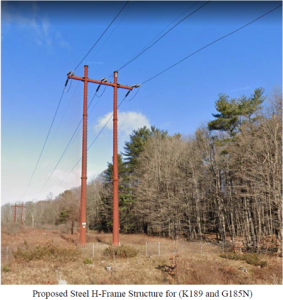Project Overview
Construction Update
The initial phases of work have begun within the right-of-way (ROW) along the entire project route. Temporary access roads – using a combination of timber matting and gravel — are being built to provide safe, adequate access for our crews to begin construction. We have also begun drilling for the new pole foundations using mobile rotary drill rigs to complete this step. In the coming weeks, we’ll start installing the new poles.
For the safety of all community members and our crews, access restrictions are in place at certain locations along the ROW where the public would normally recreate. These locations include a portion of the practice athletic fields at East Greenwich High School, a section of the walking trails at Fry Brook Recreation Area, and Hunt River Preserve. Signage and fencing is posted at these locations to clearly mark restricted areas. We would ask that these areas – as well as all areas of the active ROW – are not accessed by members of the public until it is safe to do so.
We invite members of the community to reach out to our team with any questions or concerns about the construction process.
Overview

RI Energy will upgrade the existing poles and wires that run between the Davisville Substation (Roger Williams Way, Quonset Point) and the Drumrock Substation (Centreville Road, Warwick). This includes the replacement of 162 existing structures (combination of H-frame and monopole designs) to comport with the latest federal electrical standards, as well as upgraded conductors (wires) that are better suited for carrying the increased generation from the soon-to-be-built Revolution Wind Farm. The project also includes the installation of a new fiber optic system that will greatly improve communications between substations. A total of 10 structures will be removed entirely and five existing structures will be reused.
Construction is scheduled to begin in the late spring of 2023 and conclude by the end of 2024 with restoration activities to be complete by summer 2025. The costs of the upgrades – estimated at $58.6 million (±25%) – are being funded entirely by Revolution Wind.
To review a copy of RI Energy’s application to the RI Energy Facility Siting Board, please click here.
Construction Phasing
Construction will take place over the course of several phases. Details about the timing of each phase by location will be communicated to those along the project route throughout the project, but the general plan includes:
Forestry Work: to prepare the ROW for construction access, the Forestry team will complete mowing and limited tree work within the boundaries of the ROW. Any forestry work that impacts vegetation outside the ROW will be coordinated with landowners prior to the work being completed.
Civil Work: During this phase, RI Energy contractors will install construction matting (either timber or composite) to protect the ground from the movement of heavy equipment, as well as environmental controls to protect sensitive areas along the route. The matting will be installed to create temporary access roads, as well as work pads around each new structure for the staging of equipment. Crews will also complete the drilling work necessary to install the new structures and pour cement footings in the locations where they are needed (many locations will have directly-embedded structures with no footing).
Electrical Work: Once the civil work is completed, the contractors will move on to installing the new towers and running the new wires. The wires will be pulled, using special equipment, from various locations along the ROW. The old structures and wires will be removed following the installation of the new equipment.
Restoration: Following the installation of the new towers and wires, and the removal of the old materials, crews will shift their focus to restoring the ROW. Because the matting will have provided a high level of protection, restoration in most areas is limited to clean up and lawn/vegetation restoration as needed (most locations where matting was located will naturally restore over time). In some locations, we may need to discuss replanting of trees, typically where additional access needs are located. Our team will address these needs on a case-by-case basis with property owners as we draw closer to this phase of the work.
